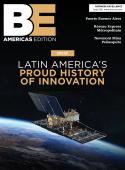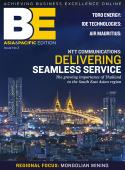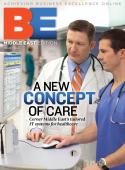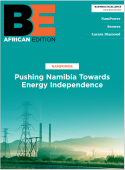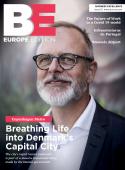Gateway to the north┬áPhenomenal growth over the past five years has presented Edmonton International Airport (EIA) with some delicious dilemmas. Diane Trenn, Paul Garbiar and Traci Bednard talk to Gay Sutton about managing exceptional growth while maintaining customer services. Rich oil reserves in AlbertaÔÇÖs oil sands; gold and diamond deposits; titanium, molybdenum and nickelÔÇöthese are just a few of the lucrative and exciting discoveries that have brought Northern Alberta to life in recent years. And while the global economies continue to tumble into recession, the hunt for oilÔÇöthat precious commodity so coveted by most of the industrialized nations of the worldÔÇöshows little sign of abating. Similarly, the value of gold and diamonds appears to be rising while share prices and hard currency are on the other end of the seesaw. Edmonton has become the gateway and service center for all those that supply or operate in these industries, and as a result its economy has been booming. With all this activity going on, it is small wonder that Edmonton International Airport has seen phenomenal growth in traffic and demand. Indeed, Edmonton Airports, which manages the Edmonton City Centre Airport, Villeneuve Airport and Cooking Lake Airport as well as the International Airport, has been working aggressively to market its services and further stimulate growth.ÔÇ£Since 2002 our domestic passenger numbers have risen by 55 percent,ÔÇØ says Diane Trenn, vice president airport operations for EIA. ÔÇ£Our trans-border market, by which I mean travel into the US and back into Canada, has grown over 140 percent, and our international traffic has grown by 326 percent. That brings our overall growth since 2002 to a whopping 70 percent.ÔÇØ EIAÔÇÖs existing infrastructure was originally designed for a theoretical maximum capacity of 5.5 million passengers annually, and growth projections at that time predicted that capacity would be reached by 2015. ÔÇ£However, in 2008 our passenger count was just over 6.4 million, so you can see weÔÇÖre already about 20 percent over our design capacity,ÔÇØ Trenn says. ÔÇ£It has been an amazing period of growth, and some of us have aged during that time frame.ÔÇØWhen it became apparent that this stellar growth was likely, EIA developed a two-pronged strategy by which it hoped to maintain customer service levels while the facilities could be expanded to meet demand. First, it initiated a rapid program of facilities expansion that would be completed in 2012; and second, it worked on innovative ways of increasing capacity with the footprint it had.One example of this is the work it has done with hotels in the area to devise customized Web check-ins for them and their customers. ÔÇ£This means that as customers check out of the hotel, the concierge or the agent can check them in for the flight, print out their boarding cards or have them sent to their PDAs before they arrive at the airport,ÔÇØ explains VP communications & passenger experience Traci Bednard. ÔÇ£That has allowed us to offload some processes.ÔÇØ Another effective initiative has been the introduction of US Quick Connect. Costing $1 million and taking a year to develop, it allows passengers transferring between destinations in the US and other airports in Canada to remain in the passenger lounges rather than going through the rigmarole of collecting their luggage on arrival, checking it in for the ongoing flight, and then going through security all over again. The transfer of baggage is done for them behind the scenes while they can relax in the passenger lounge, therefore saving on space and facilities. ÔÇ£WeÔÇÖre also working with airports in northern Canada to see if we can extend our self-serve check-in kiosks to some of them,ÔÇØ Bednard says. The result of this will be to make transfers seamless for the passenger while relieving the Edmonton facilities of considerable work.ÔÇ£In spite of all these initiatives, weÔÇÖre still running out of space,ÔÇØ says Paul Garbiar, VP infrastructure & technology. ÔÇ£We needed to embark quickly on an expansion program. So what we are working on now is a 42,000-square-meter expansion of our terminal to the south, which should increase the terminal space by about 35 percent and give us the capacity to handle nine million passengers per year.ÔÇØHowever, with capacity already stretched, any disruption to operations could be disastrous. And with five gates at the south end of the building where construction will take place, alternative strategies have had to be devised. ÔÇ£WeÔÇÖve come up with a phasing strategy that would allow us to displace those five gates into a temporary facility that will be connected to our terminal so we wonÔÇÖt lose any capacity during the extension work,ÔÇØ Garbiar says.EIA began planning the expansion program over a year and a half ago. Construction of the temporary facility is due to commence in the spring and should be completed by October this year, after which the main terminal expansion should be able to start.The building program is not, however, confined merely to increasing the terminal space. The airport has been examining all its options and is planning to introduce apron-loading buses. ÔÇ£Of course, in order to do that you need apron,ÔÇØ Garbiar says. ÔÇ£So we are in the process of expanding our apron space by 300,000 square meters. Last year we built 65,000 square meters of that space, and we will continue to do more this year.ÔÇØMeanwhile, a new combined office control tower is to be built to replace the existing undersized facility, and this should be completed in 2011. Not only will it house a new control tower for NAV Canada, but it will have the added benefit of enabling EIA to integrate all the baggage systems. Then, in order to service this larger space, the central utility plant is also to go through expansion and upgrade, and this will also come into service in 2011.Looking to the future, EIA has already started considering the next phase of expansion. And while increasing the car parking capacity has been important this time around, it recognizes that tastes are changing, and it is investigating the possibility of a light rail transit system. When it comes to identifying exactly the right services to offer the passenger, ÔÇ£We want to get ahead of the curve,ÔÇØ Garbiar says. ÔÇô Editorial research by Amber Russo┬á




